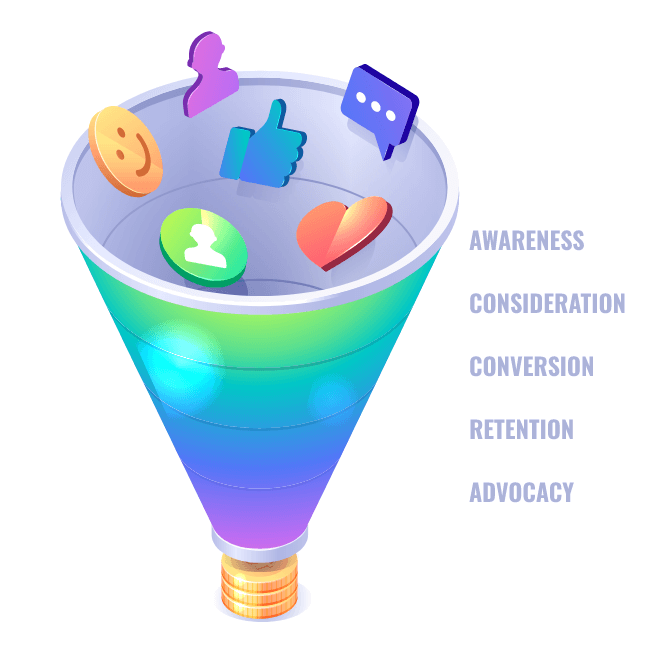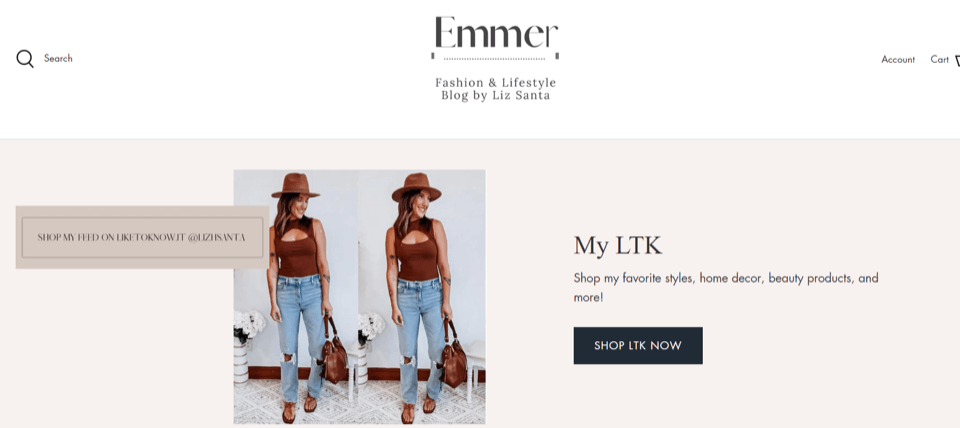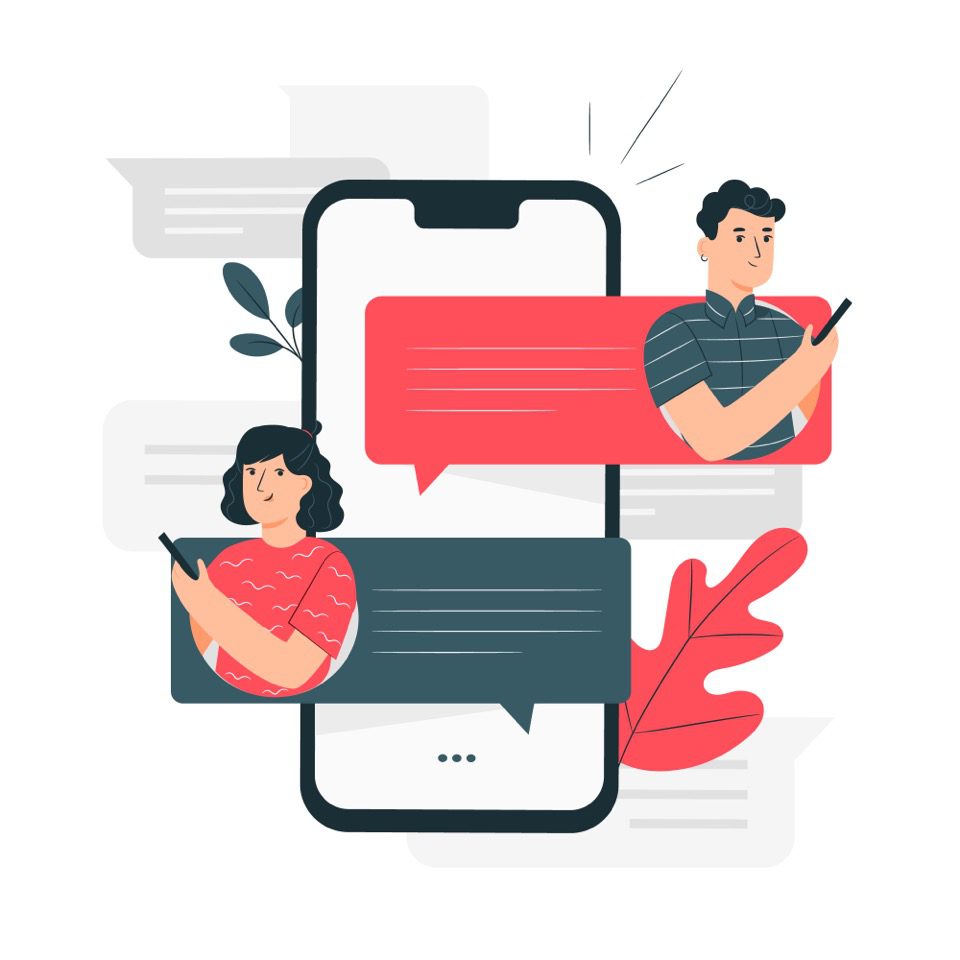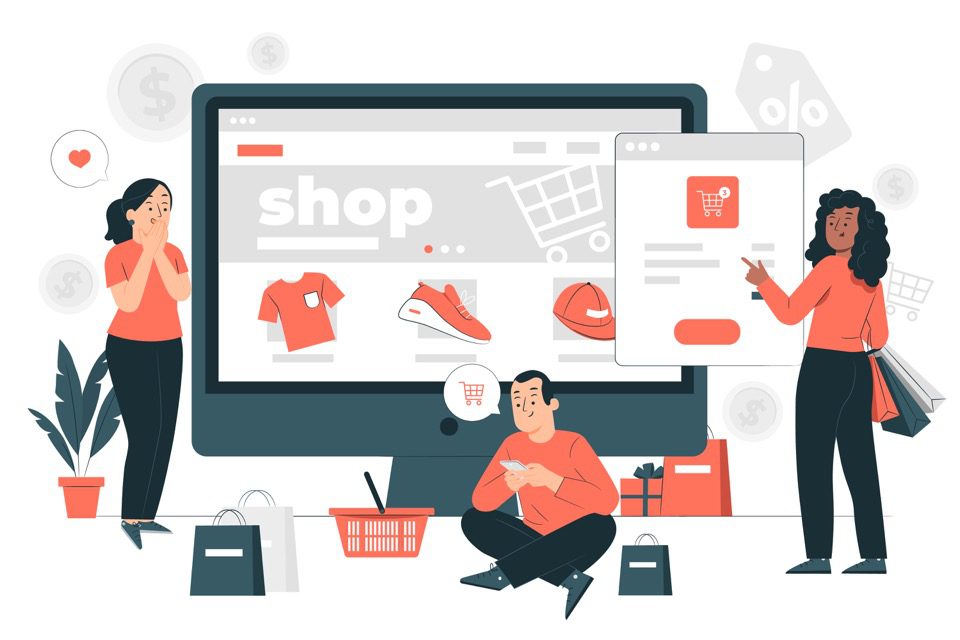Every time a consumer interacts with your brand, they have the opportunity either to continue moving along the sales funnel or to leave your store and search for your products or services elsewhere. Keeping visitors engaged with your website until they make a purchase is the goal for every ecommerce business owner.
Your customer’s experience is defined by how they interact with your brand at each touchpoint. From the moment they become aware of your store to their first visit to your online store, their first purchase, and their after-sales experience, every interaction shapes their perception of your company and affects the likelihood that they’ll buy from you again. Customers have countless online retailers to choose from, so you need to provide the best digital customer experience to stand apart from your competitors.
This guide covers the ecommerce customer journey and how to optimize its stages to convert more customers.
What Is the Ecommerce Customer Journey?
The ecommerce customer journey includes all the stages that a customer goes through in the process of purchasing from your business. It starts when a consumer learns about your brand, product, or service and continues through their conversion right up until they become loyal customers and even advocates for your brand.
The ecommerce customer journey is important because it shapes your customers’ view of your business and their willingness to purchase from you, which ultimately affects your ROI. As a business owner, you must work to improve each stage of the journey so that consumers have the best possible experience.
Why Is It Important?
Customer retention is highly dependent upon the customer’s experience. Nearly 46% of business professionals believe that customer experience should be the top priority for businesses in the next five years. Most customers are open to paying higher prices if they come with a better customer experience. Improving customer experience can enhance customer satisfaction and retention and potentially improve conversion rates.
On the flip side, bad experiences will cause you to lose customers quickly. These statistics demonstrate just how beneficial it is for online retailers to optimize the ecommerce customer journey.
Stages of the Ecommerce Customer Journey
The ecommerce customer journey describes a customer’s path to purchase. A majority of the time, your customers won’t make a purchase immediately but will spend some time getting to know your business. Understanding your target audience and their path to making a purchase is essential to improving your store and your marketing campaigns.
Understanding the stages of the ecommerce customer journey helps you identify your customer’s path to conversion. It’s also helpful to optimize your strategies so that your store can drive more sales. But what exactly are the customer journey stages, and how can you tailor your strategies for each stage?
There are five core stages you should be aware of:
- Awareness
- Consideration
- Purchase / Conversion
- Retention
- Advocacy

Awareness
The awareness stage is when potential customers find your business. This can happen through a variety of sources, including organic traffic, social media, ads, and word-of-mouth. Prospective buyers aren’t familiar with your business, so you need to let them know what your business is all about and how you can benefit them.
At this stage, it’s crucial to generate interest in your brand and show prospective customers how you provide a solution for a particular problem they have. For best results, you need to identify and target audiences who are the best fit for your products or services. This allows you to find people with a high degree of buyer intent.
Consideration
Once visitors make it to your website and show genuine interest in purchasing from you, you need to engage them. In this stage, you need to make sure visitors don’t leave your site without buying from you. You need to prevent visitors from viewing a few pages, then bouncing off of your site. You need to overcome challenges like visitors failing to add anything to their carts or not viewing your products.
When the customer experience is done right, your potential customers can go from casual browsing straight into looking at specific products they could buy. The key touchpoints in this stage include the store page, landing page, and product page. It’s important to make it easy for users to find what they’re looking for with techniques like making the site mobile-friendly.
Purchase / Conversion
In the conversion stage, potential buyers take desired actions such as adding a product to their carts and making purchases. Make it easy for customers to convert by developing a quick and seamless checkout process. Include all necessary information to make an informed purchase, such as shipping details and order confirmation, to prevent potential order issues. The main touchpoints include the shopping cart, payment processing, thank you page, and order confirmation.
In the conversion stage, the visitor becomes a customer. To provide a great experience, you’ve got to deliver on the promises you’ve made in previous stages. Inconsistent service will destroy your credibility. Be sure your advertising, marketing, sales, and service processes align to avoid disappointing customers.
You need to deliver outstanding service and maintain consistent branding throughout the ecommerce customer journey to establish trust and get positive reviews so your customers keep coming back. Satisfied, loyal customers may even advocate for your brand by telling others about your business.
Retention
Acquiring a new customer is about 6 to 7 times more expensive than keeping an existing one. In the retention stage, your customers buy from you repeatedly. Reselling to a current customer is more profitable than finding a new one.
To keep your customers coming back, you need to meet their expectations and needs by continuing to provide high-quality customer service. Continue to nurture your customers with a segmented email list. Consider offering them special promotions, discounts, and deals. Keep them updated about developments within your brand, such as new product lines.
Surveys and feedback are invaluable resources to gain helpful information to improve your products and customer experience. They help you understand your customers’ needs and identify areas when your business is either succeeding or falling short. They can also reveal new opportunities to solve their problems.
Advocacy
Most companies focus on the conversion stage, and most customers won’t make it beyond that stage. However, as you retain customers, you should also encourage them to become advocates. At this stage, your best customers are engaging with your brand at a high level. Customers who become advocates offer incredible lifetime value because they’re not only buying from you; they’re also helping other potential customers engage with your brand.
Customers in the advocacy stage will interact with you across many different touchpoints of your online presence, including both your website and your social media channels. They also share your content on their own platforms, advocating for your business. They will recommend you to their friends and family and write positive reviews, boosting your credibility among other consumers.
5 Tips to Improve The Customer Journey in Your Ecommerce Store
Knowing the different stages isn’t enough. You need to optimize your website at each stage so that it logically guides the customer to a purchase. There are many ways to improve the ecommerce customer journey; here are some of the best.
1. Use Touchpoints to Guide Consumers to the Next Stage of the Journey
If you’ve ever shopped for something online, chances are that you interacted with their brand at more than one touchpoint. Many ecommerce customers do, and they expect the experience to be consistent throughout.
Furthermore, you’ll need to ensure all these different points of contact add value to the customer experience. Great customer touchpoints will increase sales, so it’s important to consider them in your marketing strategy. Each touchpoint should be designed to get consumers to the next stage in the ecommerce customer journey.
First, identify all the touchpoints where visitors will interact with your brand before, during, and after making a purchase. Here’s a list of common touchpoints; it’s important to optimize each touchpoint so they provide a seamless experience:
- Before purchase: social media, reviews, testimonials, word of mouth, advertising, organic traffic
- During purchase: product pages, chat widget, shopping or checkout page
- After purchase: order confirmation, shipment tracking, post-purchase feedback
Optimizing these touchpoints can pay big dividends. Offering a flawless user experience at each of these touchpoints will keep customers moving through the sales funnel until they make a purchase and encourage them to come back for future purchases. This can help boost both traffic and revenue for your business.

2. Optimize Your Website for All Devices
54.4% of traffic comes from mobile devices. So if your website performs poorly on a mobile device, you’ll alienate about half of your potential customers.
Improve user experience by making your site mobile-friendly. Check web hosting to ensure the site is fast and responsive, and test your site to ensure everything is easily clickable on mobile devices. Here are some tips to optimize your website for all devices:
- Choose a reliable web host: Make sure your web host offers the speed and resources required to make your site fast and responsive. A slow and unresponsive site will irritate your customers and may cause them to look elsewhere. You also want a host that guarantees minimal downtime.
- Follow a mobile-first approach: A mobile-first approach means ensuring your website perfectly works across all the mobile and tablet devices of different resolutions and viewports. You can use Google’s Mobile-Friendly Test tool to find out where you need to make improvements for a better ecommerce customer journey.
- Test your website for cross-device and cross-compatibility issues: With so many types of devices and browsers out there, you need to ensure your website will look pristine on all devices for a great experience.
3. Use Proactive Customer Support

Proactive customer service is about getting in front of a potential issue before it escalates. If you can spot and offer support for a problem before customers even notice it, you can make sure they’re never inconvenienced.
For example, most ecommerce brands send automated emails to customers after a purchase is made, including both tracking information and expected shipping times. If there’s a delay, the brand should let the customer know and give them a new expected arrival time. This saves the customer from worrying about whether their items have been lost and having to ask customer service where their package is.
In some instances, onboarding customers may be necessary. For example, a high-tech smartwatch may require an initial tutorial to help customers learn how to effectively use the product.
Delivering relevant tips and recommendations to educate customers is another way to engage your customers and improve customer experience. A blog is a great place to keep this type of information.
Don’t wait for customers to have issues before engaging with them. Proactively prevent problems and be accessible for support. Chatbots, help centers, and FAQ pages are a great way for customers to get their answers quickly. Also, make sure your company offers multi-channel support such as social media, live chat, phone, and email.
4. Personalize Content and Offers
Personalization in ecommerce is all about creating a more tailored experience for your customers. You can add personalization across the entire ecommerce customer journey to make it relevant to each person that visits your store.
The right personalization strategy helps you define your customers’ behavior during their shopping sessions. By delivering personalized content to your customers, you can increase your conversion rate and boost customer loyalty.
You can personalize the customer experience by creating offers for people based on how they interact with your store. The objective is to let your user’s behavior trigger the offers or products you show them.
Chatbots can also be used to personalize the customer experience. They can be used to help prevent cart abandonment, determine exit intent, provide product recommendations, and make upsells.
Another great way to personalize the ecommerce customer journey is to collect customer data and send customized product recommendations and offers. For example, if a customer bought shoes, send them a cross-sell for socks. Or let them know about a new collection of shoes released through your newsletter. Sending retargeting ads to visitors who abandoned their cart is also personalized since you’re sending it to only users who have left their cart.
5. Gather as Much Data as Possible
Providing the best customer experience requires you to collect a lot of data and continually tweak your customer persona. Great data helps you understand what your ideal customer may be going through when seeking your product and what interests or characteristics they have. Understanding them and how they move through your store is crucial to producing an ecommerce customer journey that follows a psychologically-informed model. You can use heat maps to see what pages and products are the most popular with certain types of customers. Make sure to examine different segments of customers, such as first-time visitors, returning visitors, buyers, and those with long session durations but no purchases.
Look for trends, like specific drop-off points where many visitors left your site without converting. Conversely, look for commonalities between behavior. You may notice a consistent problem that caused customers to leave these pages, such as a failure to build awareness, which you can then solve.
Here are some practical tips for collecting data to craft your buyer persona and enhance the experience of potential buyers:
- Take polls and surveys and ask questions in lead capture forms to gain more knowledge about your customers.
- Consider asking questions about demographics, online shopping behaviors, and interests
Conclusion
Understanding your customers and their path to making a purchase is essential to providing a seamless experience. Ecommerce customer journey stages help you identify your customer’s path to conversion so that you can optimize your store’s strategies to drive more sales. As a business owner, creating an excellent experience for your customers means being able to wow them at each touchpoint. The more you improve your website, the more conversions you’ll have.
At BESTWEB, we’re passionate about equipping you with the right knowledge so that you can build an ecommerce empire. Follow our blog to learn more about improving your business.

